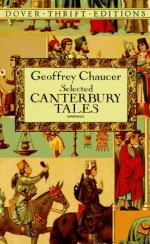|
|
The Canterbury Tales Topic Tracking: Christianity
Christianity 1: In the General Prologue, various pilgrims are introduced, including a Nun, a Monk, and a Friar, all notable figures in the Church. They represent distinct areas of Christianity, with some holding to strict worship of Christ and others overtly disobeying the laws. This initial introduction of the various religious icons on the pilgrimage foreshadows tales of sin and worship that will be told throughout the journey.
Christianity 2: As the General Prologue continues, more characters are introduced with regard to Christianity and to the Church. This time, these icons of religion represent the corruption of the church, for the Summoner summons people on a subjective basis, while the Pardoner sells fake relics.
Christianity 3: The Man of Law introduces his tale with reverence for Christ and the Church. As a man of principles and the law, he claims to command respect and comments on greed as a problem in society.
Christianity 4: The Sultan realizes in this tale that he cannot marry his woman of choice because he is a Muslim and she a Christian. The Emperor of Rome would never allow his daughter, a devout follower of Christ, to marry a Muslim. The Man of Law's Tale is illustrating the importance of loyalty to Christ.
Christianity 5: Even on the shores of Northcumberland, the strength of Christianity reigns supreme. Dame Hermengild and her husband find out who Constance is, and eventually convert to Christianity out of fear.
Christianity 6: The Friar's tale is about a summoner, who should be a good Christian and member of the Church. However, this summoner is unlawful, unfaithful to the church's governing of summons, and engages in un-Christianlike behavior, such as having sexual relations with prostitutes.
Christianity 7: The summoner and the devil are two figures representing Christianity in this tale. Because they illustrate deception in the church and do not truly represent the goodness of Christ, they wind up in hell.
Christianity 8: The summoner's tale tells of friars and their so-called devotion to God and to Christ. The friar in this tale claims to live a holy life because it is modest and impoverished. He also tells Thomas that his son's illness persists because he does not give money to the Church. He uses his position in the Church to elicit money. This example is another illustration of the futility and deception within the Church at the time.
Christianity 9: This tale details the life of a young boy of Christian valor. He worshipped Christ and sang songs to the Virgin Mary daily. It is this love for Christianity that gets him killed by the Jew.
Christianity 10: The little boy becomes a martyr for Christianity in the end of this tale by coming back to life because of his love for the Christian God. Because he desires to return to death, his status as a martyr for Christianity is cemented. He desires only to worship and sing to the Virgin Mary.
Christianity 11: The Monk's Tale is not so much a tale, but a list of short mini-tales that detail the importance of Christian worship. Many of the characters that he lists do, in fact, die because of their abandonment of God or their direct opposition to Christ.
Christianity 12: Cecilia died for the honor of God and Christianity. She suffered violent, brutal attacks and never died, most likely because of her faith in God. Her worship and loyalty to her religion allowed her to live through much pain. Although she ultimately died, her life would forever be remembered for Christian love and devotion.
Christianity 13: The Parson's Tale is simply a description/list of how to achieve penitence in Christianity. He details every step necessary to become penitent and have contrition. This tale is a classic religious and hopeful attempt to illustrate the good that still may remain in the Church.
Christianity 14: Chaucer concludes his grand Canterbury Tales with a retraction stating that any tale which brought offense to anyone is only due to his ignorance. He gives reverence to Christ once again in his retraction, reminding his readers that everything he writes is with the hope that he will be granted mercy and redemption in the afterlife.




